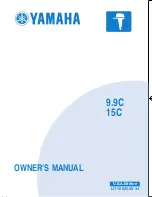
Chapter 3
11
DRAM Clock/Drive Control
1. DRAM Clock
This selecting option allows you to control the DRAM speed.
2. Drive Control
The function allows you to enable or disable the DRAM timing by SPD. When
set to Manual, you can select the DRAM CAS Latency, Bank Interleave,
Precharge to Active(Trp), Active to Precharge(Tras), Active to CMD(Trcd),
DRAM Queue Depth and DRAM Command Rate configuration. It is
recommended to keep the default setting for stable system operation.
AGP & P2P Bridge Control
1. AGP Aperture Size
This function determines the amount of system memory that is given to the AGP card.
Options range from 4MB to 256MB. This is a dynamic memory allotment in that the
AGP card will only use the amount of memory that it needs. The remaining memory not
in use will be available for the system to use. For example, if 16MB is allotted to the
AGP card and the card only needs 8MB, the remaining 8MB will be available for system
use.
2. AGP Mode
Available options: [
4X
], [
2X
] and [
1X
]
3. AGP Driving Control/Value
The [Manual] setting allows you to manually select the AGP driving value. However, it
is recommended that you keep the default setting [Auto] to allow the system to
automatically determine the appropriate AGP driving value.
4. AGP Fast Write
Selecting [
Enabled
] to allow Fast Write Protocol for 4X/2X AGP to function.
5. AGP Master 1 WS Write/Read
It is recommended to keep the default setting for stable system operation.
CPU & PCI Bus Control
1. PCI 1/2 Master 0 WS Write
When Enabled, writes to PCI bus are executed with zero wait states.
2. PCI 1/2 Post Write
Enabling this function will enhance the system efficiency.
3. PCI Delay Transaction
The chipset has an embedded 32-bit posted write buffer to support delay transactions
cycles. Select Enabled to support compliance with PCI specification version 2.1.
Memory Hole
Enabling this function will reserve the memory address space between 15MB and 16MB
for ISA expansion cards. However, enabling this function will result in not allowing the
system to have access to memory above 16MB. Please note that some expansion cards
require this setting to be enabled. The default setting is Disabled. If Auto Configuration is
enabled, you must set the DRAM timing function to 60ns or 70ns, depending on the type
of DRAM you install.
System BIOS Cacheable
Enabling this function allows caching of the system BIOS ROM at F0000h-FFFFFh,
resulting in better system performance. However, if any program writes to this memory
area, a system error may result. It is advised to leave this setting. Caching the system
BIOS results in better performance than shadowing the system BIOS.
Chapter 3
12
Video RAM Cacheable
Enabling this function will allows caching of the video RAM, resulting in better system
performance. However, if any programs write to this memory area, a system error may
occur.
Flash BIOS Protection
The motherboard manufacturer developed BIOS protection technology that protects the
System BIOS from accidental corruption by unauthorized users or computer viruses.
When enabled, the BIOS data cannot be changed when attempting to update BIOS with
the FLASH utility. When disabled, the BIOS data can be updated by using the FLASH
utility.
3-4 Integrated Peripherals
This section provides information on setting peripheral devices. By choosing the
Integrated Peripherals option from the CMOS Setup Utility menu (Figure 3-1), the screen
below is displayed. This sample screen contains the manufacturer's default values for the
motherboard.
VIA OnChip IDE Device:
Press [
Enter
] to enter the sub-menu, which contains the following items for advanced
control:
1.
OnChip IDE Channel 0/1
You can set this to disable the OnChip IDE controller if you are going to add a higher
performance IDE board
2.
IDE Prefetch Mode
Enabling this function will enhance the system efficiency.
3.
Primary/Secondary Master/Slave PIO
The four IDE PIO (programmed Input/Output) fields let you set a PIO mode (0-4) for
each IDE device that the internal PCI IDE interface supports. Modes 0 through 4 provide
successively increased performance. In Auto mode, the system automatically determines
the best mode for each device.
4.
Primary/Secondary Master/Slave UDMA
Ultra DMA implementation is possible only if your IDE device supports it and your
operating environment contains a DMA driver. If both your hard drive and software
support Ultra DMA, select [
Auto
] to enable BIOS support.
VIA OnChip PCI Device
This section provides information for setting onboard device. By choosing the Integrated
Peripherals option from the CMOS Setup Utility menu (Figure 3-5), the screen below is
displayed. This sample screen contains the manufacturer's default values for the
motherboard
Press [
Enter
] to enter the sub-menu, which contains the following items for advanced
control:
1.
VIA AC97 Audio
This feature allows you to enable/disable the onboard AC97 audio function.
2.
VIA OnChip LAN
This feature allows you to enable/disable the onboard LAN function.
3.
Onboard Lan Boot ROM
Decide whether too invoke the boot ROM of the onboard LAN chip.
Super IO Device
This section provides information on setting Super I/O device. By choosing the
Integrated Peripherals option from the CMOS Setup Utility menu (Figure 3-5), the screen






























